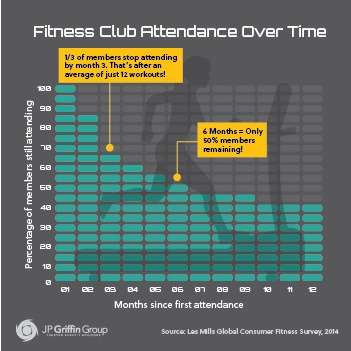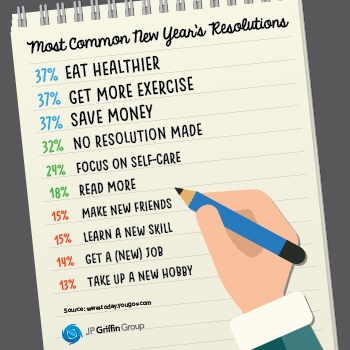 The new year is often a time for people to pause and reflect on the past year and consider things they’d like to change. This leads to new year’s resolutions, which frequently include health-related outcomes. Soon after, however, resolve to keep these resolutions starts to get a bit shaky.
The new year is often a time for people to pause and reflect on the past year and consider things they’d like to change. This leads to new year’s resolutions, which frequently include health-related outcomes. Soon after, however, resolve to keep these resolutions starts to get a bit shaky.
Some of the most common new year’s resolutions including losing weight, eating better, exercising more, and engaging in more self-care. Anyone who belongs to a fitness club knows that January is the busiest month of the year, but the crowds start to thin out around mid-February, if not sooner. By that point, most people have given up on their new year’s resolutions and the steady gym members get their favorite machines back.
The bad news is the failure to implement the healthy lifestyle changes your employees were working on might have adverse effects on their mindsets. By the end of February, if they’ve abandoned their new year’s resolutions, they’re back to their old habits, picking up fast food at lunch, downing cans of soda, and probably feeling bad about themselves.
The good news is that you can help them turn things around. Maybe they need a little extra encouragement and support to follow through with their new year’s resolutions, both of which you can provide to them with a bit of effort.
Common Times for Lifestyle Changes
Perhaps the most popular time people try to make lifestyle changes is at the turn of the year through new year’s resolutions, but it’s certainly not the only time. There are many other events in people’s lives that provide extra motivation to be healthier. They include:
- Death of a Loved One — Oftentimes, people feel a desire to make healthy lifestyle changes after the passing of a loved one, especially if the person died as a result of an unhealthy habit. Relatives of those who died from lung cancer might feel compelled to quit smoking. Similarly, loved ones of those who suffered from diabetes might be more likely to incorporate exercise and healthier foods into their lives.
- Birth of a Child or Grandchild — There’s nothing like having a brand new person completely dependent upon you to make you realize your own mortality. New parents may have trouble finding time to cook healthy meals or exercise, but it’s definitely a time they need to try. In addition, grandparents are oftentimes asked to babysit and being mostly sedentary or overweight can make the task of keeping up with a toddler (or even a growing infant ready to crawl) far more difficult.
- Mid-Life or Decade Birthdays — As we age, we become more conscious of our unhealthy habits because they affect our bodies more heavily. The Taco Bell we could handle at midnight in college would keep us up all night with heartburn in our 30’s or 40’s. Our knees start to ache, our joints creak, and we gain weight just by looking at our favorite desserts (or perhaps, that’s just how it seems). An employee’s 30th, 40th, or 50th birthday may be an opportunity for them to focus more astutely on their health and make permanent changes that help them live more fulfilled lives.
- New Medical Disease Diagnosis — It’s very common for people to feel an added incentive to make healthier lifestyle choices after they’ve received news of a medical diagnosis. This is most obvious in the case of food allergies, but good nutrition and light to moderate exercise can help employees manage lots of medical issues, including autoimmune diseases and neurological disorders (of course, with a doctor’s permission).
- A New Pet — New pets (especially young ones) are full of energy and happy new owners will need stamina to keep up with them. This is particularly pertinent if the new pet is a dog because he or she will require regular walks.
- Bathing Suit Season — This is an obvious time people become more self-conscious about weight. Lots of people start getting concerned about their summer vacations around April. They realize they gained a few pounds over the holidays (the desserts are hard for anyone to resist) and they’re only two months away from that beach trip they’ve been planning, so they start to go into crash diet mode. Instead of choosing unhealthy short-term behaviors, this can be a good time for them to adopt long-term habits they can stick with even after the vacation is over.
- Wellness Initiatives at Work — Having an extra push from work (especially one that coincides with one of the other life events on this list) can provide someone with the extra motivation they need to make healthy lifestyle changes. Wellness programs can offer a multi-faceted health approach rather than just promoting weight loss.
How You Can Help Your Workforce Keep Their New Year’s Resolutions
 Holding contests, especially in January and through the first quarter, can be a fun way to get your employees involved in wellness initiatives. It doesn’t have to be a “who loses the most weight” or “who loses the highest percentage of total body weight” scenario, although those could be a couple of the winners, if you’d like. There are plenty of other healthy behaviors and good habits to reward.
Holding contests, especially in January and through the first quarter, can be a fun way to get your employees involved in wellness initiatives. It doesn’t have to be a “who loses the most weight” or “who loses the highest percentage of total body weight” scenario, although those could be a couple of the winners, if you’d like. There are plenty of other healthy behaviors and good habits to reward.
For example, you could have a winner for the most points accumulated throughout the course of the contest. Points could be awarded for hitting water and exercise goals, fruit and veggie intake, and for hours slept.
You could also have a winner for most days exercised during the contest and most miles walked or run. For bicyclists, you’d have to equate points to more miles biked, like the same amount of points for five miles biked, rather than one mile run.
Structuring it in a way that allows multiple winners — and for multiple favorable outcomes — could encourage greater participation and allow employees to discover healthy habits that work specifically for them.
Allowing for multiple winners may also encourage some employees who hadn’t made any new year’s resolutions realize that even small changes can make a difference. It’s amazing what drinking the recommended eight glasses of water a day can do for a person only drinking two or four. Or how much better a person who eats meals filled with bread all day long will feel after subbing in some fruits and veggies.
Of course, you’d have to have some sort of awards available for the winners of your new year’s resolution contests and there’s plenty of options for how to accomplish that. You could ask all participants to chip in a few dollars that would purchase the prizes, you could try to get strategic partnerships going with healthy lifestyle businesses around you (like gyms, yoga studios, or healthy restaurants), or you could use the HR budget to purchase gift cards for winners.
Holding a walking or step challenge can also be a great way to get your workforce moving. For some people, being more active is a new year’s resolution, but they just don’t know how to incorporate it into their workday. This is a natural place for you to step in and lend a helping hand.
If you know all your staff members have some kind of step-counter (even one on their smartphones), they can use their own, but if not, you could purchase cheap counters for them. To encourage participation, organize a walking club that meets during lunch and takes pre-routed walks in the neighborhood.
You’d be surprised at how often this behavior sticks. Many workplaces find their walking clubs continue (even if it’s less frequently) once the challenge ends and you can help facilitate this through the walking routes you made. Simply leave those in an easily accessible area so your employees can continue to use them.
Another interesting pre-new year’s resolution contest idea is actually a preventative one — hold a “Zero Gain” contest during the holidays. It’s common for people to do well and achieve their goals during the year, but once the holidays hit, they go off track and have to start all over again in January.
Instead of derailing themselves by gorging on all those holiday goodies, you can encourage them to maintain their weight through the drink and dessert-laden holidays. There’s no pressure for them to lose weight, but perhaps the contest would encourage them to skip the second helping of cheesy potatoes or sit further away from the cookie table after dinner. They can weigh-in early to mid-November, then again on the first of the year (or whenever your first working day is). Whoever manages to maintain their weight wins a prize — again, offering multiple opportunities for winners.
It’s important to note that the point of these contests is not to pit coworkers against each other, but to help employees learn healthy habits that will help them achieve their new year’s resolutions and generally lead healthier lives.
For example, some people may not realize they’re only eating vegetables once a day (like in soup for lunch). Participating a contest that forces them to keep track of their veggie intake (perhaps in exchange for points) may help them find ways to incorporate them into their meals, such as making an extra effort to have a vegetable on the side at dinner or eating carrots with hummus for a snack.
Oftentimes, one of the results of challenges like these is weight loss, but lower cholesterol, blood pressure, and higher energy levels are also frequently reported. If your contest involves measuring employee weight loss, remember that some of people may not feel uncomfortable weighing in at work. You’ll either have to use the honor system and let people weigh themselves at home, or have a coordinator from your wellness program administrator conduct the weigh-ins.
If running a contest is more involved than you feel prepared to handle, there are plenty of other things you can do to encourage employees to keep their new year’s resolutions. Handing out branded reusable water bottles for employees to keep at their desks, providing healthy snacks for meetings instead of Danishes or donuts, or hiring a yoga teacher to come in and teach a class before work (or during lunch) one day a week can all be simple ways to promote wellness in the workplace.
And if you don’t already offer a wellness program, it’s a good time to start researching them and preparing for the possibility of doing so.
How These Lifestyle Changes Affect Insurance Rates
As we’ve discussed many times, the healthier your workforce, the lower your risk pool. The reason, of course, is that healthy people are less likely to incur medical expenses, especially large scale claims. This, in turn, makes it cheaper for an insurance company to provide medical coverage. Assuming you aren’t a small employer with age banded rates, a healthier workforce will typically bring down your insurance rates — or at least slow down rate increases.
Chronic conditions are a major cause of excessive health expenditures, so if your employees are able to manage their existing ones and try to prevent others from occurring, you’ll all save a lot of money in the long run.
 If your workforce is able to lower cholesterol, blood pressure, BMI, weight, fat percentage, or any combination of these things, they will be less expensive for you and your insurance company. And don’t forget that these goals may also be included in your employees’ new year’s resolutions in and of themselves. Perhaps this is the year a member of your staff finally gains control of his blood pressure and manages to lower his cholesterol to healthy levels.
If your workforce is able to lower cholesterol, blood pressure, BMI, weight, fat percentage, or any combination of these things, they will be less expensive for you and your insurance company. And don’t forget that these goals may also be included in your employees’ new year’s resolutions in and of themselves. Perhaps this is the year a member of your staff finally gains control of his blood pressure and manages to lower his cholesterol to healthy levels.
Get Off to a Good Start with New Year’s Resolutions
New year’s resolutions can be a great way to kickstart a healthier lifestyle, but the trickiest part is keeping up with them. As an employer, you can help your employees along on their quest for better wellness by making small changes in your office and hosting contests all throughout the year to entice them into participating. The best time to start these contests is January (or at least the first quarter), but it’s never too late!
What are you doing to help your employees keep their new year’s resolutions? Leave us a comment below or contact us. We’d love to hear from you!
















